
Make data-driven decisions with business process analysis
Companies or organizations that consistently produce successful outcomes may not have a detailed understanding of how those outcomes are achieved. During good times, a win is a win. But it is a dangerous state to stay in while reduced budgets, new technology, and growing demand can throw a once-successful team into chaos. But don’t worry–a process analysis may help.
Because marketing organizations typically contain strategic, creative, and operational efforts under one roof, it is an effective exercise to keep a business process analysis and reference it often.
Using this living document, you will be able to answer questions about your process like:
- How many roles are involved?
- How much time does it take to accomplish?
- What technology is used by which roles?
- What type of steps are involved (i.e. Handoffs, Wait Steps, Build Steps, Review Steps)?
- How much time is each person reporting for their role?
- Does any particular piece of the process crisscross from one team to another?
How to do it
Firstly, begin by focusing on only one of your organization’s “outcomes” or one product even if it may produce many things. You are not necessarily trying to find out “what are all the tasks my organization completes?” but rather “what does it take for my organization to complete a specific goal?”
Secondly, document the steps, who fulfills them and how. Use interviews, project management data, and organizational audits to verify all claims. Create both a textual and visual process flow diagram, and clearly store all background details. Accurately document unique vocabulary, business rules, and criteria that can be considered true throughout your organization. If different teams use different vocabulary – choose a standard and be sure everyone involved has a clear understanding when they are reporting details to you.
With a business process analysis complete and accurately attached to budget spend, you can iterate on different scenarios for your process. What would happen if we removed one handoff step…how about two or five?
Where to use it
Here are just some examples of scenarios your organization could use a process analysis to make a data-driven decision:
- Restructuring roles that are underutilized
- Evaluating new technology solutions
- Adapting to fluctuating budgets
- Determining the capacity to scale up or down
To get started, download and use our Process Analysis worksheet >
Questions? We’d love to help! Get in touch.

